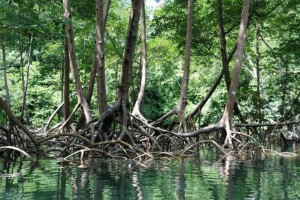From SciDev.net. April 9th, 2013
The prevailing idea that sea-level rise will inevitably wipe out mangrove forests — fragile ecosystems that protect nearby communities from natural hazards such as floods and storms — is challenged by a recent report.
Mangroves in some areas will be able to survive climate change-induced sea-level rise as they can slowly increase the level of soil in which they thrive, but only if they are managed and protected, according to ‘The response of mangrove soil surface elevation to sea level rise’ report.
Activities such as building dams on rivers and converting mangrove areas into shrimp farms may have a stronger impact on the health of mangroves than sea-level rise, the report adds. Once weakened by such changes, mangroves will be less able to adapt to changes in sea level.
“A lot of the rivers [that feed mangrove areas] are being dammed, and by doing that we reduce the freshwater flow and sediment flow to mangroves. Both can be very deleterious for mangroves,” says Anna McIvor, lead author of the report and a researcher at the University of Cambridge, United Kingdom.
“Once mangroves are degraded, they are much less likely to keep up with sea-level rise,” McIvor tells SciDev.Net.
The report surveyed key literature published from 2006 to 2011, and found that mangroves in some areas have adapted to rising sea levels and would continue to do so in the future.
But, it notes, longer-term data on the effects of sea-level rise on mangroves are missing.
“Most of the current measurements span [only] about ten years,” says McIvor. Yet, sea levels do not rise that quickly.
She says that evidence is currently also limited by the small number of locations in which mangrove studies have taken place, restricting researchers’ abilities to assess differences in local conditions and make global predictions on the future of mangroves.
